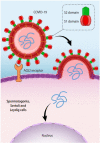Health concerns regarding the effect of the COVID-19 pandemic on male fertility
- PMID: 34352169
- PMCID: PMC8421655
- DOI: 10.5653/cerm.2021.04378
Health concerns regarding the effect of the COVID-19 pandemic on male fertility
Abstract
Severe acute respiratory syndrome coronavirus 2 (SARS-CoV-2) is a novel coronavirus found in China in 2019. The disease caused by SARS-CoV-2, coronavirus disease 2019 (COVID-19), has been found to be closely related to the cells that secrete angiotensin-converting enzyme 2 (ACE2). ACE2 is involved in the renin-angiotensin system and is widely secreted in several tissues, including the testis, which has raised concerns because organs with high expression of the ACE2 receptor are susceptible to infection. Analyses have shown that in testicular cells, such as spermatogonia, seminiferous duct cells, Sertoli cells, and Leydig cells, there is a high expression level of ACE2. Therefore, SARS-CoV-2 may damage male reproductive tissues and cause infertility. Since male infertility is an important problem, scientists are evaluating whether COVID-19 may influence male infertility through the ACE2 receptor.
Keywords: COVID-19; Male fertility; Pandemic.
Conflict of interest statement
No potential conflict of interest relevant to this article was reported.
Figures
Similar articles
-
Is there an impact of the COVID-19 pandemic on male fertility? The ACE2 connection.Am J Physiol Endocrinol Metab. 2020 Jun 1;318(6):E878-E880. doi: 10.1152/ajpendo.00183.2020. Epub 2020 May 18. Am J Physiol Endocrinol Metab. 2020. PMID: 32421367 Free PMC article.
-
Does SARS-CoV-2 Threaten Male Fertility?Adv Exp Med Biol. 2021;1321:139-146. doi: 10.1007/978-3-030-59261-5_12. Adv Exp Med Biol. 2021. PMID: 33656720
-
Impact of COVID-19 on fertility and assisted reproductive technology (ART): a systematic review.Rom J Morphol Embryol. 2022 Jul-Sep;63(3):503-510. doi: 10.47162/RJME.63.3.04. Rom J Morphol Embryol. 2022. PMID: 36588488 Free PMC article.
-
The ACE2 expression in Sertoli cells and germ cells may cause male reproductive disorder after SARS-CoV-2 infection.J Cell Mol Med. 2020 Aug;24(16):9472-9477. doi: 10.1111/jcmm.15541. Epub 2020 Jun 28. J Cell Mol Med. 2020. PMID: 32594644 Free PMC article.
-
Potential effects of COVID-19 on reproductive systems and fertility; assisted reproductive technology guidelines and considerations: a review.Hong Kong Med J. 2021 Apr;27(2):118-126. doi: 10.12809/hkmj209078. Epub 2021 Apr 15. Hong Kong Med J. 2021. PMID: 33853972 Review.
Cited by
-
Investigating the Role of Serotonin Levels in Cognitive Impairments Associated with Long COVID-19.Chonnam Med J. 2024 Sep;60(3):141-146. doi: 10.4068/cmj.2024.60.3.141. Epub 2024 Sep 25. Chonnam Med J. 2024. PMID: 39381125 Free PMC article. Review.
-
Potential effects of COVID-19 on reproductive health: a mini review.Am J Transl Res. 2021 Dec 15;13(12):13321-13327. eCollection 2021. Am J Transl Res. 2021. PMID: 35035678 Free PMC article. Review.
-
Long-term complications of COVID-19.Am J Physiol Cell Physiol. 2022 Jan 1;322(1):C1-C11. doi: 10.1152/ajpcell.00375.2021. Epub 2021 Nov 24. Am J Physiol Cell Physiol. 2022. PMID: 34817268 Free PMC article. Review.
References
-
- Cavalcante MB, Sarno M, da Silva AC, Araujo Junior E, Barini R. Is there any possible link between COVID-19 and human infertility? J Matern Fetal Neonatal Med. 2020:1–2. - PubMed
-
- Le Tortorec A, Matusali G, Mahe D, Aubry F, Mazaud-Guittot S, Houzet L, et al. From ancient to emerging infections: the odyssey of viruses in the male genital tract. Physiol Rev. 2020;100:1349–1414. - PubMed
LinkOut - more resources
Full Text Sources
Miscellaneous


